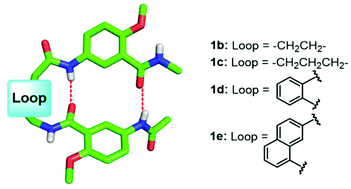An unnatural tripeptide structure containing intramolecular double H-bonds mimics a turn hairpin conformation†
Abstract
A series of unnatural tripeptides, each consisting of two aromatic γ-amino acid residues and an ϖ-amino acid residue, are designed to probe their folding into hairpin conformations. The ϖ-amino acid residues, with aliphatic or aromatic spacers of different sizes, serve as the loop of the hairpins. Studies based on one-dimensional (1D) 1H NMR performed at different concentrations, solvent polarity, and temperature, along with 2D-NMR studies, demonstrated that the doubly H-bonded aromatic γ-amino acid residues play important roles in driving these tripeptides into the hairpin conformation. The loop based on 5-aminovaleric acid, which offers a four-carbon (CH2)4 spacer, enhanced the stability of the corresponding hairpin, while loops having a shorter, a longer and a more rigid spacer disfavored the formation of the hairpins. Results from computational studies are in good agreement with the experimental observations. Furthermore, the crystal structure of peptide 1b revealed the expected hairpin conformation in the solid state. This turn motif, which contains H-bonded aromatic γ-amino acid residues as the core unit and an ϖ-amino acid residue serving as the loop, provides a new platform that can be used to obtain a variety of turn conformations by incorporating diverse amino acids into the loops.

- This article is part of the themed collection: Supramolecular chemistry in OBC


 Please wait while we load your content...
Please wait while we load your content...